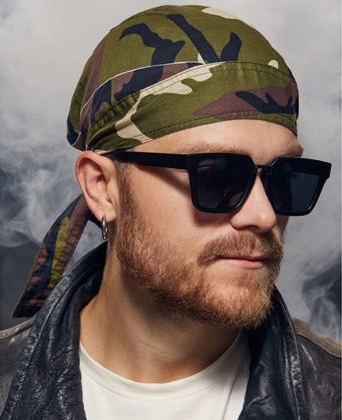A headband is a comfortable, beautiful and practical headdress for both women and men, as well as for children. This item can be easily sewn with your own hands if you know the basics of sewing and how to use patterns and instructions from master classes on making such items.
How to sew a bandana for a woman with your own hands
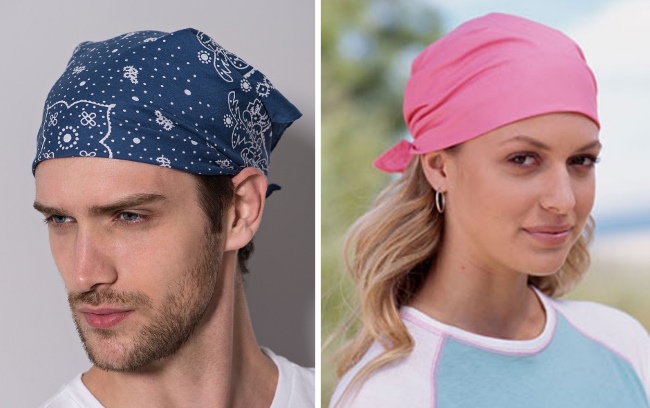
What types of bandanas are there? Choosing a model
It is customary to distinguish the main models of bandanas for women:
- Kerchief - a triangular bandana on the head. It is usually made of cotton. This is one of the most popular types of bandanas.
- Bandana accordion - an original headdress for women.
- Square bandana - cotton fabric of standard size 60 cm by 60 cm.
- Transformer bandana — is a multifunctional headdress that has no seams. The model is sewn from elastic fabric, which makes it suitable for anyone.
- Bando – a headdress in the form of a bandage. The bandeau is usually worn on the forehead. This bandana is made of fabrics such as tulle, velvet, satin or lace. Sometimes the bandeau is decorated with decorative stones.
- Bandana with elastic. For the summer, they are sewn from natural fabrics (linen, cotton). In cold weather, warm materials are chosen: wool, suede, leather or even fur. If you look at the types of bandanas with an elastic band, they usually have ties, with or without a visor. A scarf with a visor is a multifunctional headdress that can be worn all year round. A lace bandana usually has ties on the back to adjust the size. The main advantage of a bandana with an elastic band is that it fits tightly to the head.
Materials, tools and equipment
To sew a regular square bandana, you will need fabric measuring at least 60 cm by 60 cm and threads for finishing the seams. You will also need:
- sewing machine (if available) or needle;
- threads;
- ruler;
- graph paper;
- pencil;
- chalk;
- scissors;
- iron.
Recommended fabrics
A women's headband can be sewn from almost any material. Before sewing the product with your own hands, you need to decide on the density of the fabric. For example, you can choose a thick or transparent material. The headband can be made of calico, cambric or natural materials such as chiffon, silk and cotton. If the product is intended for the autumn or winter period, it is worth choosing warm fleece.
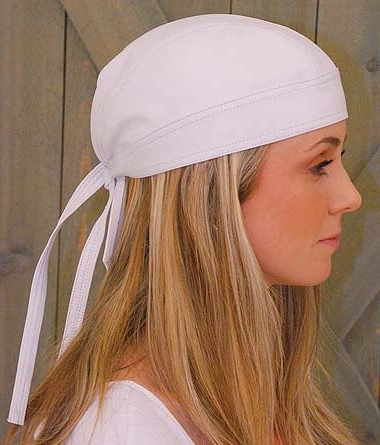
Medium weight cotton, such as muslin, is best for making bandanas. Silk or satin make very beautiful bandanas. Using fabric with interesting prints is also popular when making bandanas.
Another factor to consider when choosing a fabric is how it feels on your skin. You can find a good-looking fabric, but the skin underneath may not breathe at all or may even rub, causing irritation. When choosing a fabric, you should also pay attention to its coloring. Camouflage or denim look interesting.
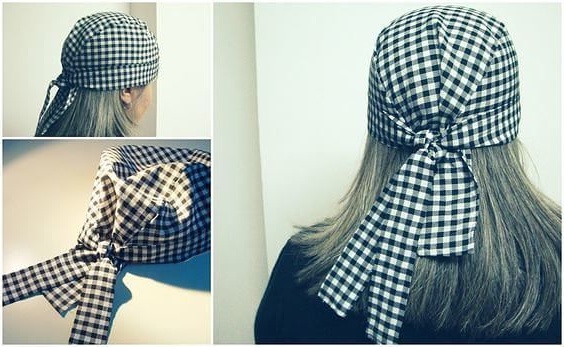
The fabric recommended for sewing a headdress depends on the type of bandana:
| Kerchief | Cotton, linen |
| Square bandana | Cotton, linen |
| Transformer bandana | Polyester and other elastic fabrics |
| Bando | Tulle, velvet, satin, lace |
| Bandana with elastic | Linen, cotton, wool, suede, fur and leather |
Head circumference measurements
Before sewing a headband, you need to carefully take measurements and then make a pattern based on them. The standard size of a bandana for women is 60 cm by 60 cm. However, you cannot neglect taking measurements, because there is a risk of still guessing wrong with the size.
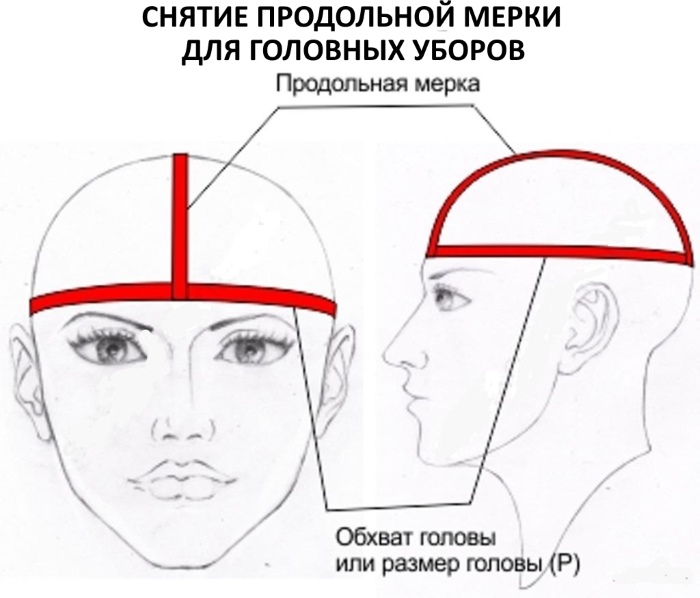
A headband can have different sizes, depending on the woman's head circumference. If you need to sew a bandana for a head circumference of 57 cm, then the pattern will have to be adjusted to this size.
To do this, you will have to divide the circumference by 1.414, that is, by the square root of 2. Accordingly, the minimum length of a bandana for a girl with a head circumference of 57 will be approximately 41 cm. Also, 20 cm should be left for ties. After taking measurements, you can start making a pattern.
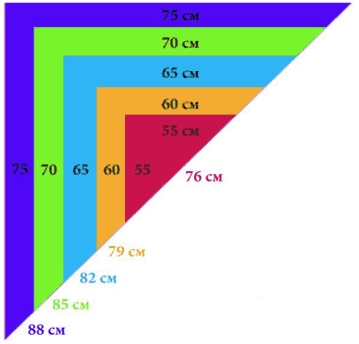
Pattern
For smoother seams, it is best to first make a pattern on special paper - graph paper. You can buy it together with the fabric. On it, you need to mark the dimensions of the future bandana and also leave 3 cm on each side for allowances.
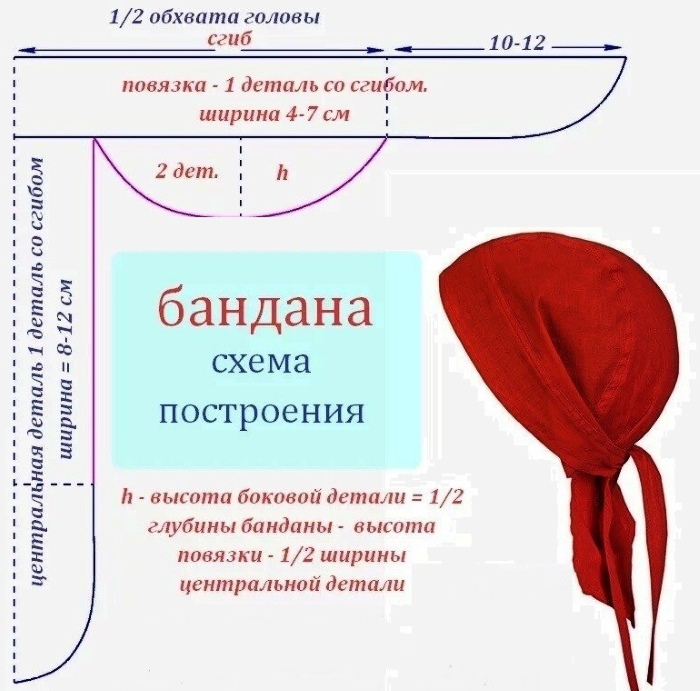
Once the shape is outlined, it needs to be cut out and then the paper pattern transferred to the fabric, tracing it with chalk. And only then the bandana itself is cut out.
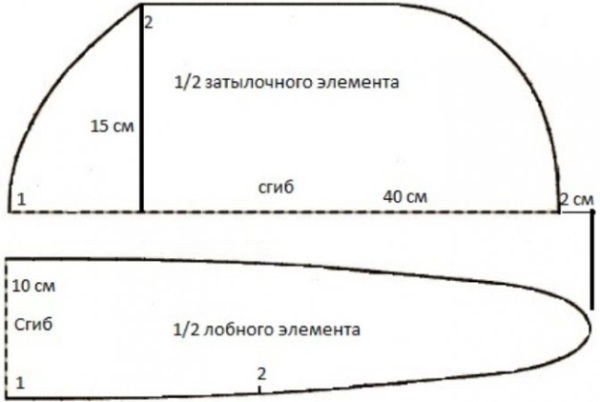
Step by step instructions
- The first stage of work will be the preparation of the fabric. It is better to buy it with a reserve at once, so that if something happens, you can simply cut off the excess. The fabric should be from 60 cm by 60 cm or more.
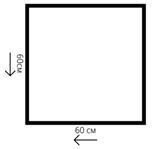
- Then you need to measure the circumference of your head and use the formula to calculate the minimum length of the product.
- After this, you need to make a pattern, taking into account the parameters and wishes for the length.
- Once you have cut out the pattern, you can try on the bandana and adjust the length. You still need to leave 5 cm for the seams.
- A headband requires mandatory seam treatment. This can be done with either threads in the same color as the fabric or with contrasting ones to create an interesting design. To make the product look beautiful, it is necessary to use a zigzag stitch. It will protect the fabric from crumbling and other damage.
- After processing the seams, the product must be ironed well, taking into account the characteristics of the fabric.
- You can start decorating.

How to decorate a headdress
A women's headband is often decorated with additional materials. Various patches can be used as decoration for a bandana. There is a huge selection in craft stores: patches with flowers, logos of musical groups and films. Some of them are attached by heating an iron, while others can be sewn on by hand.
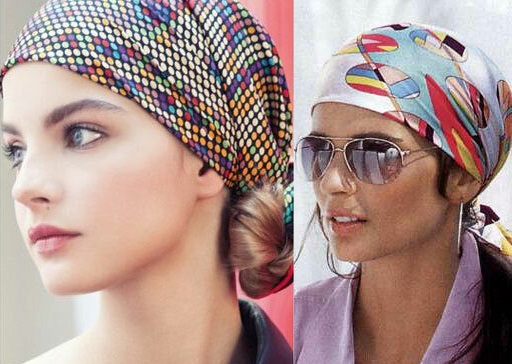
The bandana can be decorated with paints or fabric markers. You can use special stencils to make the design more successful. Bandanas decorated with precious stones, beads or sequins also look impressive.
After applying any decoration, the product must be allowed to dry completely. It is necessary to always follow the instructions for the products used to decorate the bandana. Fabric paints and markers may have special instructions for washing and further care of the bandana.
How to sew a bandana for a man with your own hands
Model selection
Men's bandanas, just like women's, come in different types. Most popular among men:
- classic square bandanas;
- transforming bandanas.

These types of headwear are the most functional. They combine ease of use and versatility - the main qualities that men value in a bandana.
Materials, tools and equipment
To sew a men's head bandana you will need:
- textile;
- sewing machine or needle;
- threads in the color of the fabric;
- chalk;
- graph paper;
- scissors;
- pencil;
- ruler;
- iron.
Recommended fabrics
For the production of men's bandanas, it is better to choose natural and breathable fabrics - cotton and linen. If a man prefers a transformable bandana, it is better to make it from elastic fabric. There are many modern materials on the market that can be suitable for both everyday wear and an active lifestyle.

You should approach the choice of fabric color responsibly, as men and women have different tastes in clothing. It is more common for men to choose single-color materials. You can choose a color for a bandana based on the general range of a man's wardrobe. It all depends on what colors predominate in his clothes. A universal option for making a bandana would be classic blue or black denim.
Measurements
The circumference of a man's head is often larger than that of a woman's. This should be taken into account when creating a drawing. As a rule, the circumference parameter varies from 55 cm to 60 cm. All parameters are individual and for these purposes the best solution would be to use a centimeter tape.
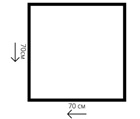
Based on these, you should add 15-20 cm. This is done taking into account the errors and the need to process the edges of the product, as well as further tying the bandana itself on the head.

Pattern
An important stage in sewing a men's bandana is the pattern. It has its own subtleties, but is almost no different from a women's one.
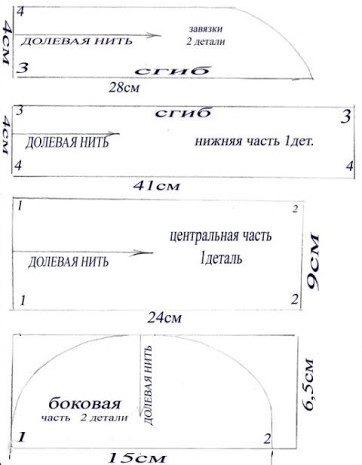
The main differences are:
- Dimensions.
- Number of parts.
A detailed drawing should be prepared, this is done on graph paper. When marking, it is worth considering that you need to leave from 3 cm to 5 cm on each side, which are used for hemming the edges. On average, to sew a men's bandana, you need to measure a rectangle of 80 cm by 40 cm or a square of 70 cm by 70 cm.
With these dimensions, you can sew the most optimal option. Then, using scissors, you need to cut out the part itself from paper, put it on the fabric and outline it with chalk. Only after this can you start cutting out the shape from the fabric.
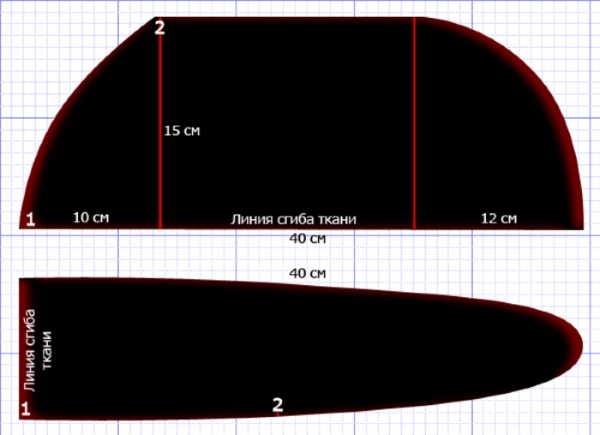
Step by step instructions
- It is worth buying fabric with a reserve for unforeseen circumstances. The excess can be cut off or used to make another bandana. The minimum size will be 100 cm by 100 cm.
- The next step is to measure the head circumference using a tape measure. Based on the measurements, the minimum parameters of the product are calculated using a formula.
- The most important stage can be called the pattern. In this operation, the parameters of length and error should be taken into account.
- After cutting out the pattern, an important step will be to adjust the length of the bandana. Usually about 5 cm is left for seams.
- Afterwards, it is necessary to process the seams. This is done to give the product the necessary shape and appearance. In the male version, it is best to use threads that match the color of the fabric. When sewing, a zigzag stitch should be used. This stitch is the most reliable.
- The final stage will be ironing the seams. In order not to spoil the product, you should take into account the characteristics of the fabric and set the temperature mode.
- The product can be decorated if desired.
How to decorate a headdress
The men's bandana option does not require a lot of decorations and details. It is best to get by with a small badge that will complement the man's image. It is best to attach the badge to the side. A great option would be a badge with a favorite performer or the branch of the military in which he served.
A metal skull on a black bandana will look good. This will perfectly emphasize charisma and make the headdress more individual.
How to sew a children's bandana
Model selection
There are many different types of bandanas for children. When choosing a bandana for a child, most parents prefer the following models:
- kerchief;
- transformable bandana;
- bandana with ties;
- various types of bandanas with a visor for sun protection.
The type of bandana is best chosen taking into account the individual characteristics of the child. A bandana with ties is ideal for those children who often lose something due to their high mobility. A cap with a visor will be the best option for those who live in a hot climate and are often under the scorching sun.

Materials, tools and equipment
To sew a bandana for a child, you will need:
- textile;
- sewing machine or needle;
- threads in the color of the fabric;
- chalk;
- graph paper;
- scissors;
- pencil;
- ruler;
- elastic band (for a bandana with an elastic band);
- iron.
Recommended fabrics
Children's summer hats should be sewn from light natural fabrics. Cotton and linen are excellent. It is better to choose fabric with various prints. This way the child will like the headdress more. The fabric market is so diverse that it is easy to find material with images of the characters of the child's favorite cartoons or just a successful repeating pattern.

When choosing fabric, it is worth considering that it should not be thick. Preference should be given to breathable materials. They will help to avoid overheating of the head, as a result, this will protect against sunstroke.
Measurements
When sewing a bandana for children, you should take into account a number of factors:
- Gender of the child.
- Age, as children grow over the years, the bandana may become too small.
- The interests of the child.
Average head circumference parameters are about 45 – 50 cm. Each case is individual and this should be taken into account. You can’t do without using tape. It is best to add 5 – 10 cm to these parameters in case of hemming the edges and minor errors.
Pattern
For smoother seams, it is best to first make a pattern on graph paper. On it, you need to sketch out the dimensions of the future headdress. It is always necessary to leave a small distance for further processing of the edges of the product.

Once the shape is marked out, it needs to be cut out and then chalked to transfer everything from the paper to the fabric. Then the bandana is cut out of the fabric.
Step by step instructions
- It is worth buying fabric with a reserve for unforeseen circumstances. The excess can be cut off or used to make another bandana. The minimum size will be 100 cm by 100 cm. Any product begins with the choice of fabric. For children, this is especially important so that their heads do not get hot. It is worth buying fabric with a small reserve. A square of 70 cm by 70 cm will be quite enough for sewing.
- At this stage, you will need a measuring tape. It needs to measure the circumference of the child's head. Knowing all the data and using a special formula, you can find out the minimum parameters of the bandana.
- Many errors in further operations are made due to incorrect patterning. At this stage, a drawing of the future product with all the necessary parameters is formed.
- Length adjustment is a very important operation that follows immediately after the pattern. About 5 cm is usually left to form the seams of the product.
- An important stage is processing the edges. They should be formed with a zigzag stitch. You can use threads of different colors when making. This will be an excellent solution for a girl's bandana. If it is intended for a boy, it is better to use threads that match the tone of the fabric.
- Finally, iron the item or steam it. This is necessary to give it a finished shape. The temperature setting should be chosen correctly, depending on the fabric's characteristics.
- It wouldn’t hurt to add some decorative details.
How to decorate a headdress
Decorating a baby bandana can be a great space for imagination. It can be a great entertainment for the child too if you work together to create the design.
For girls, the best decorative elements are:
- Bows.
- Flowers.
- Butterflies.
- Icons.
For boys, the following are more suitable:
- Patches.
- Icons.
- Embroidery.
These features will help to form a sense of style in the child and develop individuality.
Bandana for babies
The best bandana option for the little ones is a model with ties. Such a thing will hold well even on the most active child.
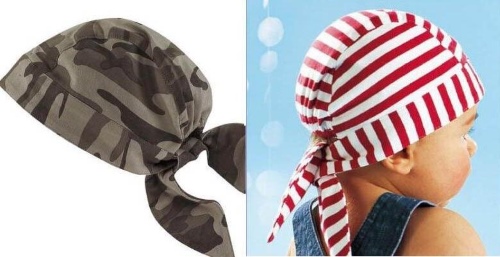
When choosing a material, you should definitely give preference only to natural fabrics - cotton and linen. It is safe for the child.
Before creating a pattern, you need to measure the circumference of the child's head and add 20 cm to the resulting length - this will be the length of the future ties. You will need two patterns: one in the form of a semicircle and one in the form of a rectangle for the ties. You need to cut out 2 semicircles, as well as 2 rectangles.
As an example, take: the central part is 30 cm by 10 cm and the lower part is 80 cm by 8 cm. It is necessary to sew 2 semicircles and the central rectangle. Then, process the edges of the remaining rectangle with a zigzag stitch, after which the ties can be sewn to the main part so that an equal amount of material remains on both sides.
The bandana for the child can be considered ready.
How to decorate a headdress
The decoration for the bandana of the little ones should be chosen with great care. In this situation, it is better to refuse any bows and frills. It is better to get by with a little embroidery. This does not pose a threat to the newborn. Neat embroidery will definitely not harm the baby's health. For this type of decoration, it is better to use bright shiny threads. They should not be chosen based on the gender of the child. You should focus on the color of the eyes. Shiny colored threads will highlight them perfectly.
Useful tips
Sewing a bandana can be greatly simplified and improved by following these tips:
- Measurements for making a bandana can be taken by wrapping the tape 1.5-2.5 cm above the eyebrows, slightly above the ears and at the point on the back of the head that protrudes the most. It is better to measure the head several times to avoid mistakes. Ideally, to correctly measure the circumference of the head, you can call someone for help. This will make the result more accurate.
- If you are afraid that the bandana will fall off while you wear it, you can buy a 1.5 cm wide elastic band in advance and leave some space in the pattern to sew in the elastic band.
- It is a good idea to wash the fabric before sewing the bandana. This will prevent further shrinkage of the material.
- Since children's bandanas require less material, you can use various fabric scraps that can be found in any home. And characteristic decor will help give the headdress a more childish look.
- If the bandana is made as a gift to relatives and friends, you can embroider the initials of the person to whom the headdress will be presented with beautiful and thick threads. Thanks to this, the bandana will become unique.
- A bandana is a universal headdress in hot sunny weather. Wearing a bandana on your head will protect both children and adult women and men from sunstroke. It is worth remembering that black fabric heats up more in the summer, so for protection from the sun, when sewing a bandana, give preference to light tones of material.
- It is best to wash such a thing together with colored items. The mode should be selected based on the type of fabric. This will help preserve the product for many years to come. Cleanliness of the headdress is very important, because if you neglect it, there is a high chance of dandruff and rapid greasiness of the hair.
Video master classes on sewing bandanas
Another interesting master class:

